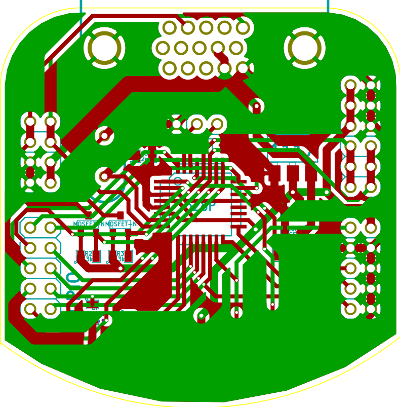Josef Gajduek is author of this project. TWILight – VGA I2C breakout board is completely open source you can find all design files and firmware related details on his offcial blog which i have mentioned at the end of this article. You can find 25$ I2C adapter and even one can use Raspberry Pi to interface with I2C device but having it on your notebook seemed unlike quite useful thing and thats reason to make this board happen. Although some article said that I2C is not supported on Intel cards on linux (all of this has been tested on Dell Latitude E5530 which does have Intel HD4000), so author decided to try anyway. A lot of technological things has been changed since 2008 when it was written.
Board Design Details
One of the problems (or features) with the built-in I²C bus is, that it does have internal 5V pull-up resistors. This is only useful as long as you do not want to talk to lower voltage devices. Because of that he decided to make board with VGA connector and level shifter. He had a few Atmega328s around from previous project and they were not of any more use, He added one on the board as well to serve as a GPIO expander + LED driver. You can never do anything wrong with several LEDs.

The AVR runs on 12MHz crystal (just on the edge of what it can handle at 3.3V) and does have 4 LEDs connected to its PWM channels + 10 GPIOs on one of the external headers (2 more LEDs are connected to GPIO0 and GPIO1). There is also one LED for power indication, but in the final build, this one was left unpopulated. As for the I²C, headers for both 5V and 3.3V lines are in the top left and top right. 8-pin ICSP header is used to load code into the Atmega. UART in the middle is for debugging/bootloader if that is ever needed.
Specialized ICs which can be used to level shift I²C exist, but this seemed unnecessary as you can get away with just two N-MOSFETs. Originally, the boards were meant to be manufactured at Itead studio, but later, because of the cool purple solder mask, He decided to go with OSH instead.
More details about Twilight-VGA I2C breakout board (design file, source code), Please refer to this link, http://blog.atx.name/twilight-vga-i2c-breakout-board/
 BINARYUPDATES.COM EMBEDDED SYSTEMS TRAINING
BINARYUPDATES.COM EMBEDDED SYSTEMS TRAINING